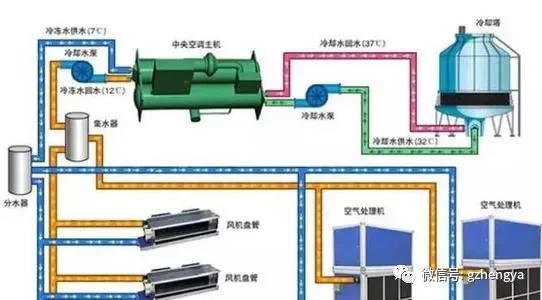The central air conditioning system refers to the use of water as a refrigerant or heat transfer medium. The cooling or heating of the water is first sent to the fan coil (the indoor unit of the central air conditioning system of the water system), and the heat or cooling energy is transferred to the air by fresh air or mixed air. A central air conditioning unit is installed in a designated area. Do you know the standard procedure for installing a central air conditioning water system?
Central Air Conditioning System Diagram

Step 1: When water & electricity arrive at the project location for installation and decoration, the location of the central air conditioning fan coil and the piping design must be determined first. This is to avoid conflicts with the electrical and water pipes after the installation of the air conditioning system, ensuring the proper functioning of the central air conditioning system. At this point, fan coils should be installed to avoid the entry of dust and contaminants. Install the piping, including supply and return pipes, condensate pipes, signal pipes, etc., and protect the refrigerant pipe joints.
Step 2: Lift the outdoor central air conditioning unit 24 hours after initial installation; test the central air conditioning system to measure the size and position of the pipe tank.
Step 3: After the second installation or once the indoor ceiling installation is completed, install the air exhaust vent and then test the central air conditioning system to meet the cooling and heating requirements. Be sure to choose an appropriate location to ensure the heat dissipation of the unit.
There are some precautions in the design of the installation location: the cold and hot air tanks increase. Because refrigerants are heavier than air, they will disperse on the ground once leaked. Therefore, if the air conditioning unit is installed in a closed room, it must have good ventilation.
To meet maintenance needs, check and clean the evaporator and condenser heat exchanger pipes. The unit must have sufficient space for pumping and dedicated space larger than the evaporator, and the length of the condenser unit should be suitable. Complete drainage around the unit and the entire machine room should be ensured to prevent condensed water from affecting the normal drainage system, which could impact the normal operation of the central air conditioning system.
The above is the standard procedure and precautions for installing a central air conditioning water system. In the central air conditioning industry, there is a saying: "Three points product, seven points installation." It shows that installation issues are very important in the after-sales process of central air conditioning equipment. Regardless of how good the product’s actual advantages are, installation issues must be addressed properly. You should find a professional central air conditioning installation factory or construction team to avoid later operational issues.

